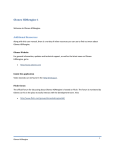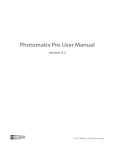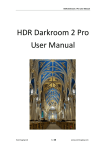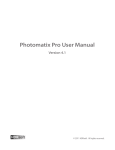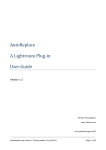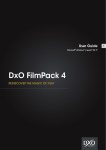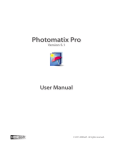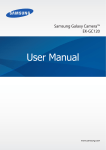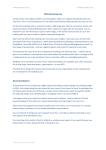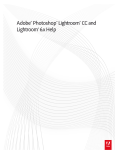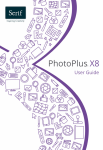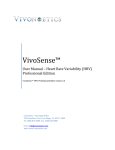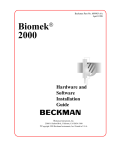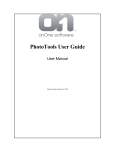Download User Manual
Transcript
Oloneo PhotoEngine 1 Welcome to Oloneo PhotoEngine. Additional Resources Along with this user manual, there is a variety of other resources you can use to find out more about Oloneo PhotoEngine. Oloneo Website For general information, updates and technical support, as well as the latest news on Oloneo PhotoEngine, go to: http://www.oloneo.com Inside the application Video tutorials can be found in the Help Workspace. Flickr forum The official forum for discussing about Oloneo PhotoEngine is hosted on Flickr. The forum is monitored by Oloneo so this is the place to easily interact with the development team. Visit: http://www.flickr.com/groups/oloneophotoenginetalk/ Oloneo PhotoEngine 1 Table of Contents Oloneo PhotoEngine 1........................................................................................................................1 Additional Resources ................................................................................................................................ 1 Table of Contents ...............................................................................................................................2 Overview: Main Features ...................................................................................................................7 Introduction .............................................................................................................................................. 7 HDR ToneMap™: high dynamic re-exposure in real-time ........................................................................ 7 HDR ReLight™: take pictures then set-up lighting .................................................................................... 7 HDR DeNoise™: remove noise and keep details ....................................................................................... 7 Complete, high-end RAW photo processing ............................................................................................. 8 Overview: the User Interface..............................................................................................................9 Introduction .............................................................................................................................................. 9 The Browse Workspace ............................................................................................................................ 9 The Edit Workspace ................................................................................................................................ 10 The Help Workspace ............................................................................................................................... 11 Managing the Workspaces ..................................................................................................................... 12 The Browse Workspace .................................................................................................................... 13 Overview ................................................................................................................................................. 13 The Browsing toolbar .............................................................................................................................. 14 The Thumbnail list................................................................................................................................... 15 The Image Info panel .............................................................................................................................. 17 The project creation panels .................................................................................................................... 17 The Recent Projects panel ...................................................................................................................... 18 The Edit Workspace ......................................................................................................................... 20 Overview ................................................................................................................................................. 20 The edited image .................................................................................................................................... 21 The Info panel ......................................................................................................................................... 21 The Image toolbar ................................................................................................................................... 21 The image setting panels ........................................................................................................................ 23 Oloneo PhotoEngine 2 The Timeline panel .................................................................................................................................. 24 The Help Workspace ........................................................................................................................ 26 User Interface Main Controls............................................................................................................ 28 Overview ................................................................................................................................................. 28 The Setting Panel .................................................................................................................................... 28 The Slider ................................................................................................................................................ 29 The Color Wheel ..................................................................................................................................... 30 The Curve Editor ..................................................................................................................................... 32 The Color Curve Editor ............................................................................................................................ 34 File Drag and Drop ........................................................................................................................... 36 HDR ToneMap: Creating a Project..................................................................................................... 38 Overview ................................................................................................................................................. 38 Step 1, locating the photos ..................................................................................................................... 39 Step 2, selecting the photos.................................................................................................................... 40 Step 3, adding the photos to the project selection panel ...................................................................... 41 Step 4, creating the HDR ToneMap project ............................................................................................ 42 HDR ToneMap: Single Raw Processing .............................................................................................. 46 Overview ................................................................................................................................................. 46 Step 1, locating the photo....................................................................................................................... 46 Step 2, creating the project .................................................................................................................... 47 Using the file menu ................................................................................................................................. 47 HDR ToneMap: Editing a Project ....................................................................................................... 49 Overview ................................................................................................................................................. 49 HDR ToneMap: Tone Mapping tools ................................................................................................. 51 HDR ToneMap: Auto Tone Mapper ................................................................................................... 53 Overview ................................................................................................................................................. 53 Using the Auto Tone Mapper.................................................................................................................. 53 HDR ToneMap: Local Tone Mapper .................................................................................................. 55 Overview ................................................................................................................................................. 55 Main Tone Mapping settings .................................................................................................................. 55 Exposure settings .................................................................................................................................... 57 Oloneo PhotoEngine 3 Contrast settings ..................................................................................................................................... 58 HDR ToneMap: Advanced Local Tone Mapper................................................................................... 60 Overview ................................................................................................................................................. 60 Detail settings ......................................................................................................................................... 61 Edge Sharpen .......................................................................................................................................... 63 Panorama Mode ..................................................................................................................................... 64 HDR ToneMap: Global Tone Mapper ................................................................................................ 66 Overview ................................................................................................................................................. 66 Working with the Global Tone Mapper .................................................................................................. 66 HDR ToneMap: the Natural HDR Mode ............................................................................................. 68 Overview ................................................................................................................................................. 68 Using the Natural HDR Mode.................................................................................................................. 68 HDR ToneMap: Basic Image Settings................................................................................................. 70 Low Dynamic Tone settings .................................................................................................................... 70 HDR ToneMap: Advanced Image Settings ......................................................................................... 72 Photographic Print Toning ...................................................................................................................... 72 Brightness Curve ..................................................................................................................................... 73 Saturation Curve ..................................................................................................................................... 74 Color Equalizer ........................................................................................................................................ 76 HDR ToneMap: Presets .................................................................................................................... 79 HDR ToneMap: Batch Processing ...................................................................................................... 84 Overview ................................................................................................................................................. 84 Batch creation ......................................................................................................................................... 84 Running the Batch ................................................................................................................................... 89 HDR ToneMap: the Timeline............................................................................................................. 93 HDR ToneMap: Saving and Exporting ................................................................................................ 97 HDR ReLight: Creating a Project ...................................................................................................... 102 Overview ............................................................................................................................................... 102 Step 1, locating the photos ................................................................................................................... 103 Step 2, selecting the photos.................................................................................................................. 103 Step 3, adding the photos to the project selection .............................................................................. 105 Oloneo PhotoEngine 4 Step 4, creating a HDR ReLight project ................................................................................................. 106 HDR ReLight: Editing a Project ........................................................................................................ 108 Editing light sources .............................................................................................................................. 109 Editing Image settings ........................................................................................................................... 113 HDR ReLight: the Timeline .............................................................................................................. 117 HDR ReLight: Saving and Exporting ................................................................................................. 121 HDR DeNoise: Creating a Project .................................................................................................... 126 Overview ............................................................................................................................................... 126 Step 1, locating the photos ................................................................................................................... 127 Step 2, selecting the photos.................................................................................................................. 128 Step 3, adding the photos to the project selection panel .................................................................... 129 Step 4, creating the HDR DeNoise project ............................................................................................ 130 HDR DeNoise: Editing a Project....................................................................................................... 133 Overview ............................................................................................................................................... 133 HDR DeNoise: the Natural HDR Mode ............................................................................................. 135 Overview ............................................................................................................................................... 135 Using the Natural HDR Mode................................................................................................................ 135 HDR DeNoise: Image Settings ......................................................................................................... 137 Low Dynamic Tone settings .................................................................................................................. 137 HDR DeNoise: Advanced Image Settings ......................................................................................... 139 Photographic Print Toning .................................................................................................................... 139 Brightness Curve ................................................................................................................................... 140 Saturation Curve ................................................................................................................................... 141 Color Equalizer ...................................................................................................................................... 143 HDR DeNoise: the Timeline ............................................................................................................ 146 HDR DeNoise: Saving and Exporting................................................................................................ 150 Export Options ............................................................................................................................... 155 Overview ............................................................................................................................................... 155 Exporting to JPEG .................................................................................................................................. 155 Exporting to TIFF ................................................................................................................................... 157 Color Management ........................................................................................................................ 160 Oloneo PhotoEngine 5 Overview ............................................................................................................................................... 160 Display Preferences............................................................................................................................... 160 External Editor Preferences ............................................................................................................ 162 Adobe Lightroom plug-in................................................................................................................ 163 Overview ............................................................................................................................................... 163 Enabling the plug-in .............................................................................................................................. 163 Using the plug-in ................................................................................................................................... 165 Plug-in Export Presets ........................................................................................................................... 170 Legal Notices ................................................................................................................................. 171 Oloneo PhotoEngine 6 Overview: Main Features Introduction Oloneo PhotoEngine is a professional Raw Photo processing, HDR creation, Tone Mapping and advanced image editing software. It is the result of over four years of research and development in Computational Photography. Main features: HDR ToneMap: HDR edition and Tone Mapping in real time HDR ReLight: photo relighting in real time HDR DeNoise: noise reduction without loss of details Raw photo processing Adobe Lightroom plug-in and direct export to Adobe Photoshop HDR ToneMap™: high dynamic re-exposure in real-time A full real-time, high dynamic range (HDR) re-exposure module to merge and edit single or multiple RAWs, JPEGs or TIFFs. Capable of creating a wide range of styles, from realistic to artistic, HDR ToneMap includes four tone mapping engines, Natural HDR™ processing mode, auto-exposure correction with fine-tuning, auto-contrast, detail size and threshold controls, halo control, edge sharpening, ghost removal tools, auto-align, auto-orientation, batch processing with interactive mode, over 40 interactive factory presets and user-defined presets, and more. You also have the possibility to modify exposure the traditional way by turning off tone mapping while still benefiting from a 32-bit, ultra-wide gamut and full resolution environment. HDR ReLight™: take pictures then set-up lighting An image-based relighting tool using merged RAWs, JPEGs or TIFFs to control in real-time the settings of individual light sources after the photos are taken. For each light source, parameters include white balance, brightness, temperature, tint and color. Other features are the auto-detection of ambient light and each light source's color temperature. HDR DeNoise™: remove noise and keep details A powerful image noise and grain reduction tool using stacked RAWs, JPEGs or TIFFs, with the added Oloneo PhotoEngine 7 benefits of full detail preservation, no smoothing and no artifacts, even with low-contrast and low-light photos. Complete, high-end RAW photo processing Oloneo PhotoEngine also features a complete RAW and image processing module including a customizable Color Curve Equalizer™ with hue/saturation, hue/luminance and hue/hue curves, a brightness curve, a unique color saturation curve, a color toning tool, an advanced white balance control and more. PhotoEngine handles most RAW photo formats, with thumbnail and preservation of key EXIF metadata, fully supports color management and uses the ICC profiles generated by most colorimeters on the market today. Oloneo PhotoEngine 8 Overview: the User Interface Introduction PhotoEngine uses a tabbed interface to allow you to focus on the task at hand. There are three main tasks grouped in three Workspaces: Browsing files and creating projects in the Browse Workspace Editing an image in the Edit Workspace Getting help in the Help Workspace The Browse Workspace This is where PhotoEngine starts. Use the Browse Workspace to: Display and browse your photos Select photos Create an HDR ToneMap, HDR ReLight or HDR DeNoise project Oloneo PhotoEngine 9 The Edit Workspace PhotoEngine switches to the Edit Workspace after loading or creating a new project. Use the Edit Workspace to: Edit your photos Save the current project Export the edited photo Oloneo PhotoEngine 10 The Help Workspace The Help Workspace is where you get help on Oloneo PhotoEngine. Use the Edit Workspace to: Watch tutorial videos Read the user manual Oloneo PhotoEngine 11 Managing the Workspaces PhotoEngine automatically switches from workspace to workspace when needed. You can also select which Workspace is displayed at any time. Selecting the Workspace to be displayed: Click on the Browse, Edit or Help buttons located in the top menu bar Or, select Browse, Edit or Help in the Tools menu Oloneo PhotoEngine 12 The Browse Workspace Overview The Browse Workspace is where you display your photos and create new projects. There are five main areas in the Browse Workspace: 1: Browsing toolbar where you select the directory to be displayed 2: Photo thumbnails of the currently displayed directory 3: Image Info panel showing the currently selected photo 4: Project creation panels 5: Recent Projects toolbar and panel Oloneo PhotoEngine 13 The Browsing toolbar The Browsing toolbar allows you to select the folder displayed by PhotoEngine and to set the size of thumbnails. There are multiple ways to select an image folder: Direct selection using the system File or Folder Dialog Selecting a recently browsed folder Typing the path of the folder Selecting a folder: Click on the “…” button Using the system File Dialog navigate to a folder containing image files Select a file then click the Open button PhotoEngine starts displaying the thumbnails Selecting a folder using the menu: Click on the Down Arrow button Click on Browse (Using File Dialog) ... Or, click on Browse (Using Folder Dialog) ... Using the File or Folder Dialog, navigate to your image folder Close the dialog PhotoEngine starts displaying the thumbnails Selecting a recent folder using the menu: Oloneo PhotoEngine 14 Click on the Down Arrow button Select one of the listed folders PhotoEngine starts displaying the thumbnails Editing the folder path: Click in the address bar Type or cut and paste the path to your folder Press the Return or Enter key to validate PhotoEngine starts displaying the thumbnails Setting the thumbnail size: Click and drag the slider located at the right of the Browsing toolbar The Thumbnail list After selecting a folder, PhotoEngine displays the photos and project files contained in the folder. There are two file categories: PhotoEngine Project files, displayed on a blue background Image files, displayed on a gray background with the file extension displayed at the top left corner Oloneo PhotoEngine 15 Opening a project file: Double click on the Project file thumbnail PhotoEngine switches to the Edit Workspace and load the project Opening a Single JPEG, TIFF, Radiance or Raw file: Double click on the file thumbnail PhotoEngine switches to the Edit Workspace and load the image Selecting several image files: Scroll the thumbnail list until you see the set of photos you want to use Oloneo PhotoEngine 16 Click on the first photo in the set Shift-Click on the last photo in the set Scroll the thumbnail list until you see the set of photos you want to use Control-Click on each photo Or: A green frame is displayed around the selected photos. You can create a new project after selecting the images. Read the following chapters to learn how to create an HDR ToneMap, HDR ReLight or HDR DeNoise project from the selected images. The Image Info panel The Image Info panel displays key Exif data of the selected photo. The project creation panels Several panels located at the right of the screen allow you to create new PhotoEngine projects. Read the following chapters to learn how to create an HDR ToneMap, HDR ReLight or HDR DeNoise project. Oloneo PhotoEngine 17 The Recent Projects panel All the projects that you create or edit are automatically added to the Recent Projects panel located at the bottom of the screen. This panel allows you to quickly open and edit a recent project without having to locate the folder where the project file is stored. Oloneo PhotoEngine 18 Opening a recent project file: Double click on a project thumbnail located in the Recent Projects panel PhotoEngine switches to the Edit Workspace and load the project Setting the number of displayed files: Click on the menu located at the top left of the Recent Projects panel Select the number of files to be displayed Oloneo PhotoEngine 19 The Edit Workspace Overview The Edit Workspace is where you edit your photos and projects. There are five main areas in the Browse Workspace: 1: Edited image 2: Image Info panel 3: Image toolbar 4: Image setting panels 5: Timeline panel Oloneo PhotoEngine 20 The edited image The displayed image is not just a preview. This is the final image with all the settings applied. PhotoEngine has the unique capability of displaying in real time all your changes including Tone Mapping. Seeing the image at full resolution: Click anywhere in the image Click again to zoom back Panning the image at full resolution: Click anywhere in the image to zoom Click and drag to pan the image The Info panel The Info panel displays the image histogram and the RGB values of the pixel currently under the mouse pointer. The histogram is updated in real time and is always up to date. The Image toolbar The Image toolbar is located at the top of the image. It allows you to zoom, rotate, flip the image and set the white balance. Oloneo PhotoEngine 21 Seeing the image at full resolution: Click on the button located at the left of the Image toolbar Click again to zoom back Rotating the image: Click on the second or third button located in the Image toolbar Flipping the image: Click on the fourth or fifth button located in the Image toolbar Using the white balance tool: Click on the Eye Dropper button located in the Image toolbar Click anywhere in the picture to set the neutral point. When done, click again on the Eye Dropper button to turn it off Oloneo PhotoEngine 22 The image setting panels The panels located at the right allow you to edit the image settings. The available settings depend on the type of project you are working on. Read the following chapters to learn how to edit an HDR ToneMap, HDR ReLight or HDR DeNoise project. Oloneo PhotoEngine 23 The Timeline panel Everything you do is automatically recorded in the Timeline panel located at the left of the screen. You can click on a Timeline level to go back in time and see the image at a previous step of the edition process. Read the following chapters to learn how to use the timeline with an HDR ToneMap, HDR ReLight or HDR DeNoise project. Oloneo PhotoEngine 24 Oloneo PhotoEngine 25 The Help Workspace Use the Help Workspace to learn how to use Oloneo PhotoEngine. Watching a video tutorial: Click on one of the links located in the Video Tutorials panel PhotoEngine opens a new web page in your default web browser and displays the video Reading the user manual in a web browser: Click on the Open Page in Browser button located at the top Oloneo PhotoEngine 26 PhotoEngine opens a new web page in your default web browser Oloneo PhotoEngine 27 User Interface Main Controls Overview PhotoEngine uses several User Interface Controls that are important to master. These main controls appear in many places in the user interface. The main controls are: Setting panels Sliders Color Wheels Curve Editors The Setting Panel The Setting Panel is a box that groups related settings. Panels have three main areas: 1: Title bar 2: Video Help button 3: Contents box You can hide and reveal the contents of a Setting Panel. Hiding the contents: Oloneo PhotoEngine 28 Double click on the Title Bar located at the top of the panel Double click again to unhide Getting help: Click on the Video Help button located at the top right of the panel The Slider The slider allows you to edit a setting using the mouse pointer, the keyboard or by entering a value. Oloneo PhotoEngine 29 Dragging the cursor: Click on the blue slider cursor Drag to change the value Dragging the cursor with high accuracy: Hold the Control-key Click on the blue slider cursor Drag to change the value Moving the cursor with the keyboard: Click on the blue slider cursor Press the keyboard arrows to move the cursor Entering a value: Click in the numeric box located at the right of the slider Type the value Press the Enter, Return or Tab key to validate Resetting a slider to default value: Double-click the numeric box The slider returns to its default value The Color Wheel Oloneo PhotoEngine 30 The slider allows you to quickly select the tint and saturation of a color. There are three parts in the color wheel: 1: Tint wheel 2: Saturation bar 3: Color preview Setting the color saturation: Click on the cursor located in the horizontal bar Drag to change the value Setting the tint: Click on the cursor located in the circular part Drag to change the value Oloneo PhotoEngine 31 The Curve Editor PhotoEngine uses a sophisticated curve editor for high accuracy image editing. Adding a point: Click anywhere on the curve Oloneo PhotoEngine 32 You can add up to ten points to a curve. Deleting a point: Click on an existing point Press the Delete-key Right-click on an existing point Select Delete Selected Point in the menu Or: Editing the curvature: Click and drag one of the displayed arrows Oloneo PhotoEngine 33 Changing the curve mode: Right-click the curve Select Linear, Catmull-Rom or Bézier Spline Mode in the menu The Color Curve Editor The Color Curve Editor is similar to the Curve Editor. By default, the curve points can only slide along the vertical axis. Oloneo PhotoEngine 34 Changing how points move: Right-click the curve Select Free Mode or Vertical Lock Mode in the menu Oloneo PhotoEngine 35 File Drag and Drop Instead of using the Browse Workspace to select or open files, you can directly drag and drop images from the Windows Explorer to PhotoEngine. Drag and Drop images to the Image Selection panel: Locate your files using the Windows Explorer Select the images, start drag Drop over the Image Selection Panel in the Browse Workspace You can drag and drop JPEG, TIFF or Raw photos to the Image Selection Panel. Oloneo PhotoEngine 36 Drag and Drop images to the Browse Workspace: Locate your file using the Windows Explorer Select one image or project file, start drag Drop over Edit Workspace You can drag and drop JPEG, TIFF, Raw photos, Radiance files and PhotoEngine project files to the Edit Workspace. Oloneo PhotoEngine 37 HDR ToneMap: Creating a Project Overview An HDR ToneMap project requires two or more photos. For better results the photos must share the same aperture and same ISO. Each of the photos should show the same scene taken at different shutter speeds. The easiest way to achieve that is to set your camera in Aperture Priority mode (Av or A mode) and enable the bracketing feature. The three or more photos should cover the entire dynamic range of the photographed scene. In other words: The photo with the shortest shutter speed should not contain overexposed highlights The photo with the longest shutter speed should not contain underexposed shadows A good starting point is to take three photos spaced of 2 EV (Exposure Value). For instance: Photo 1: -2EV, 1/1000s Photo 2: 0EV, 1/250s Photo 3: +2EV, 1/60s Scenes with a very high dynamic range may require more than three photos. For high quality results, it is recommended to reduce the Exposure Value and increase the number of photos. For instance: Photo 1: -2EV, 1/1000s Photo 2: -1EV, 1/500s Photo 2: 0EV, 1/250s Photo 2: +1EV, 1/125s Photo 3: +2EV, 1/60s Creating the project is done in four steps: Step 1: locating the folder containing the photos Oloneo PhotoEngine 38 Step 2: selecting a set of bracketed photos Step 3: adding the set to the Project Image Selection panel Step 4: creating the project Step 1, locating the photos In order to create a new HDR ToneMap project, you have to first display the photos needed for the project in the Browse Workspace. Selecting a folder and displaying the thumbnails: Return in the Browse Workspace Click on the “...” button located in the top Browsing toolbar Using the File Dialog, navigate to the folder containing your photos Oloneo PhotoEngine 39 Click on the Open button The Browse Workspace now displays the photos contained in the folder you just selected. Step 2, selecting the photos Selecting photos: Scroll the thumbnail list until you see the set of photos you want to use Click on the first photo in the set Shift-Click on the last photo in the set Oloneo PhotoEngine 40 Or: Scroll the thumbnail list until you see the set of photos you want to use Control-Click on each photo A green frame is displayed around the selected photos. Step 3, adding the photos to the project selection panel Add the photos selected at the previous step to the Project Image Selection panel. Adding photos to the Project Image Selection panel: Select the images as explained in step 2 above Click on the Add button located at the bottom of the Project Image Selection panel If the panel already contains photos from a previous project, you have first to clear the Project Image Selection list. Removing all photos from the Project Image Selection panel: Click the Clear button located at the bottom of the Project Image Selection panel Removing one photo from the Project Image Selection panel: Click on one of the small thumbnails located in the Project Image Selection list Oloneo PhotoEngine 41 Click on the Remove button located at the bottom of panel You are now ready to create an HDR ToneMap project. Step 4, creating the HDR ToneMap project At this point, PhotoEngine can create the HDR ToneMap Project. The HDR ToneMap panel should display: “Ready to create HDR ToneMap Project!” HDR ToneMap projects have two options: Auto Align and Ghost Removal. What is Auto Align? If you are not using a tripod the camera may move when bracketing. The Auto Align feature attempts to align the photos when assembling the images. When to use Auto Align? Use Auto Align only when taking photos handheld. Never use Auto Align when using a tripod. The additional processing always slightly degrades the resulting image. For high quality results, use a tripod and turn Auto Align off. What is Ghost Removal? The Ghost Removal feature attempts to detect and remove moving peoples and objects in a set of photos. When to use Ghost Removal? Use Ghost Removal only when photographing non static scenes such as: crowds, cars, trees in windy Oloneo PhotoEngine 42 condition, waves, etc. Never use Ghost Removal for static scenes such as: architecture, real estate, interior design, etc. The additional processing always slightly degrades the resulting image. How to help the Ghost Removal feature? Ghost Removal is a very complex technology and may fail. For instance, it is not possible to remove several moving objects when they overlap across several photos. The reason is that none of the photos contains the background. The best way to avoid issues is to increase the number of photos. Instead of taking just one set of bracketed photos, you can take two. Though the exposures remain the same for the two sets, the additional images give PhotoEngine more data to work with. What is the difference between Ghost Removal Method 1 and Method 2? The two methods use very different approaches to detect and remove moving objects. In most cases, Method 2 is superior to Method 1 especially with photos containing many moving objects. By default, it is recommended to use Method 2. If Method 2 fails, try Method 1. Enabling Auto Align: Click on the Auto Align checkbox located in the HDR ToneMap panel Click again on the checkbox to turn it off Enabling Ghost Removal: Click on the Ghost Removal menu located in the HDR ToneMap panel Select Method 1 or Method 2 Select No Ghost Removal to turn it off Oloneo PhotoEngine 43 After choosing the HDR ToneMap options, you are ready to create the project. Creating the HDR ToneMap project: Click the Create HDR ToneMap Project button located at the bottom of the HDR ToneMap panel PhotoEngine automatically switches to the Edit Workspace and starts loading the photos. What to do when the HDR ToneMap panel displays an error message? When your photos do not contain Exif data or have missing Exif data, the HDR ToneMap Panel will display an information message such as: “Shutter speed values are required to build an HDR ToneMap Project”. If this happens you can enter missing data by hand. The Project Image Selection panel works like a small spreadsheet. You can click in any cells to enter a missing value. Manually setting missing data: Click in the cell with the missing value in the Project Image Selection panel Type the missing Shutter Speed, F-Number or ISO value Press the Tab key to validate Repeat until all missing values are entered Oloneo PhotoEngine 44 Oloneo PhotoEngine 45 HDR ToneMap: Single Raw Processing Overview HDR ToneMap is also a powerful Raw processing tool. Tone mapping can greatly improve a single Raw photo. In addition to Raw files, HDR ToneMap can be created from a single TIFF, JPEG or Radiance file. Single files supported by HDR ToneMap: Raw Photo 8-bit or 16-bit TIFF image JPEG image Radiance 32-bit High Dynamic Range Image file How to create an HDR ToneMap from a single file: Step 1: locating the folder containing the photo Step 2: double click the photo thumbnail Step 1, locating the photo In order to create a new HDR ToneMap project, you have to first display the folder containing the photo you want to process. Selecting a folder and displaying the thumbnails: Return in the Browse Workspace Click on the “...” button located in the top Browsing toolbar Using the File Dialog, navigate to the folder containing your photos Click on the Open button The Browse Workspace now displays the photos contained in the folder you just selected. Oloneo PhotoEngine 46 Step 2, creating the project Simply double-click on the photo thumbnail to create the project. Creating an HDR Project from a single file: Scroll the thumbnail list until you see the photo you want to use Double-click on the photo thumbnail PhotoEngine automatically switches to the Edit Workspace and starts loading the photo. Read the next chapter to learn how to edit an HDR ToneMap project. Using the file menu You can also create an HDR ToneMap project with the File menu. Opening a file with the File menu: Press Ctrl-O or select Open... in the File menu In the File Dialog, set the filter to the type of file you want to open: JPEG, TIFF, RAW, Radiance or All Using the File Dialog, locate the file Click on the OK button PhotoEngine automatically switches to the Edit Workspace and starts loading the photo. Read the next chapter to learn how to edit an HDR ToneMap project. Oloneo PhotoEngine 47 Oloneo PhotoEngine 48 HDR ToneMap: Editing a Project Overview To learn how to create an HDR ToneMap project read the previous chapter. After creating or loading a project, the image is displayed in the Edit Workspace with default settings. When editing an HDR ToneMap project the Edit Workspace contains three main areas: 1: the Timeline and Preset panels on the left of the screen 2: the edited image 3: the Tone Mapping and image settings on the right To edit the image simply click and drag the various sliders located in the right panels. PhotoEngine Oloneo PhotoEngine 49 automatically updates the image in real-time. Oloneo PhotoEngine 50 HDR ToneMap: Tone Mapping tools PhotoEngine offers four Tone Mapping tools: Auto Tone Mapper Local Tone Mapper Advanced Local Tone Mapper Global Tone Mapper What is the Auto Tone Mapper? The Auto Tone Mapper uses a single slider to control all the Tone Mapping effects. It uses sophisticated algorithms that control Tone Mapping, exposure, contrast, brightness and saturation parameters in a fully automated way. Except setting the overall strength of the effect, you have no additional controls. If you are new to HDR and Tone Mapping, it is probably where you want to start. If you are experienced, use the Local Tone Mapper tool which offers more detailed controls. What is the Local Tone Mapper? The Local Tone Mapper is a default Tone Mapping tool. It offers a right balance between control and complexity. What is the Advanced Local Tone Mapper? The Advanced Local Tone Mapper is similar to the Local Tone Mapper but adds even more options. It is the tool of choice for the advanced and expert users. What is the Global Tone Mapper? The Global Tone Mapper offers an entirely different approach to Tone Mapping. Use it for medium dynamic range images and when you are looking for natural results. Images produced with the Global Tone Mapper tend to be soft with low contrast. What is the best tool to use? All of them! PhotoEngine always work in real time. You can switch instantly from one tool to the other. Oloneo PhotoEngine 51 Whether an expert user or not, try not to stick to a single workflow. Explore the possibilities: you will be pleased by what you discover! Selecting the Tone Mapping tool: Click on the Menu located at the top of the High Dynamic Tone Mapping panel Select the tool you want to use PhotoEngine immediately updates the image and displays the options of the selected tool. Remark: You can entirely turn off the Tone Mapping module by selecting None. Use this option when you want to edit the image the traditional way using exposure, brightness, contrast and curves while still benefiting from the high precision of the 96-bit per pixel rendering engine. Oloneo PhotoEngine 52 HDR ToneMap: Auto Tone Mapper Overview The Auto Tone Mapper works in an entirely automated way. Use it if you are new to HDR and Tone Mapping. With only one setting to play with, it is fun and easy to use. When you have gained more experience, you can switch to the Local Tone Mapper which gives more control. The Auto Tone Mapper settings are displayed in the High Dynamic Tone Mapping panel when Auto Tone Mapper is selected in the menu located at the top. Using the Auto Tone Mapper The Auto Tone Mapper is easy to use. Simply drag the Strength slider and watch the image change in real time. Editing the Tone mapping setting: Drag the Strength slider Oloneo PhotoEngine 53 Strength value range: 0 to 100: low Tone Mapping effect, medium high light recovery, natural image 100 to 150: medium Tone Mapping effect, full highlight and shadow recovery, natural image 150 to 200: high Tone Mapping effect, full highlight and shadow recovery, detail increase 200 to 300: extreme Tone Mapping effect, unnatural image Oloneo PhotoEngine 54 HDR ToneMap: Local Tone Mapper Overview The Local Tone Mapper is the default Tone Mapping tool. It is selected by default when creating a new project. The Local Tone Mapper settings are displayed in the High Dynamic Tone Mapping panel when Local Tone Mapper is selected in the menu located at the top. The settings are grouped in three categories: Tone Mapping settings Exposure settings Contrast settings Main Tone Mapping settings The main Tone Mapping settings are controlled by the TM Strength and Detail Strength sliders. Editing the Tone mapping settings: Drag the TM Strength slider Drag the Detail Strength slider Oloneo PhotoEngine 55 What is TM Strength? TM Strength stands for Tone Mapping Strength. It is the Tone Mapping master control. Increase the value to reduce global image contrast while keeping the detail contrast unchanged. The higher the value the more you will recover burned highlights and underexposed shadows. TM Strength values: By default the value is 0 meaning no Tone Mapping. The image is displayed “as is”. For most images, use values from 0 to 65. In this range, Tone Mapping varies from low to fairly high while maintaining a natural image. For special effects, use values from 65 to 100. Around 85 the Tone Mapping becomes extreme with global contrast near to zero. High values usually require an increase in Detail Strength. Summary: 0: default value, no Tone Mapping 0 to 65: regular range, low to high Tone Mapping, natural rendering 65 to 100: high to extreme Tone Mapping, special effects TM Strength value can become negative?! Absolutely and it is a unique feature! For negative values, PhotoEngine switches to a special mode and applies an Anti-Tone Mapping to the image. This mode is usually needed for very peculiar applications such as artificially increasing the Dynamic Range of a low dynamic image or for special effects. Anti-Tone Mapping can bring interesting effects to black and white photos. With it, you can easily add a film noir effect to your black and white photos. Oloneo PhotoEngine 56 What is Detail Strength? Detail Strength controls the detail contrast (also called micro contrast). Increasing its value will increase details visibility. Detail Strength values: By default the value is 0 meaning that the image details are unchanged. For most images, leave the value to zero or slightly increase it up to 100. In this range, detail contrast varies from low to medium and maintains a natural image. For special effects, use values from 100 to 300. High values are useful to create busy images with a high level of detail (the “grunge effect”). Summary: 0: default value, image details are unchanged 0 to 100: regular range, low to medium details, natural rendering 100 to 300: medium to extreme details, special effects Detail Strength value can become negative?! Yes and it is again a unique feature! For negative values, PhotoEngine actually removes details from the image. At -100, all image details are removed. Use this special value range for impressionist effects, to simulate old photos, to create soft, ethereal black and white photos, etc. Exposure settings Exposure settings are controlled by the Auto-Exposure checkbox and the Exposure and Fine Exposure sliders. Editing the Exposure settings: Turn on or off Auto-Exposure by clicking the Auto-Exposure checkbox Drag the Exposure slider Drag the Fine Exposure slider Oloneo PhotoEngine 57 What is Auto-Exposure? By default, PhotoEngine automatically computes the best possible exposure. The exposure is changed when you modify the TM Strength and Detail Strength values. In most cases, leave the Auto-Exposure enabled. Auto-Exposure may fail when working with photos incorrectly bracketed or with severely underexposed images. In that case, disable Auto-Exposure and set the exposure manually with the Exposure and Fine Exposure sliders. What is Exposure and Fine Exposure? The Exposure and Fine Exposure sliders allow you to correct the exposure that was automatically computed by PhotoEngine. For most images, the Exposure slider should remain unchanged unless you disable Auto-Exposure. Use the Fine Exposure to fine tune exposure after using TM Strength and Detail Strength. Contrast settings Contrast settings are controlled by the Auto-Contrast checkbox and the Contrast slider. Editing the Contrast settings: Turn on or off Auto-Contrast by clicking the Auto-Contrast checkbox Drag the Contrast slider Oloneo PhotoEngine 58 What is Auto-Contrast? By default, PhotoEngine automatically computes the best possible contrast. The contrast is changed when you modify the TM Strength and Detail Strength values. You should leave the Auto-Contrast enabled in most situations. Auto- Contrast may fail when working with photos incorrectly bracketed or with severely underexposed images. In that case, disable Auto- Contrast and set the contrast manually with the Contrast slider. What is Contrast? The Contrast slider allows you to correct the contrast that was automatically computed by PhotoEngine. Use the Contrast slider to fine tune contrast after using TM Strength and Detail Strength. Oloneo PhotoEngine 59 HDR ToneMap: Advanced Local Tone Mapper Overview The Advanced Local Tone Mapper offers expert settings and allows a finer control of Tone Mapping. Use the Advanced Local Tone Mapper after mastering the Local Tone Mapper and when you need to fine tune a Tone Mapped image. The Advanced Local Tone Mapper settings are displayed in the High Dynamic Tone Mapping panel when Advanced Local Tone Mapper is selected in the menu located at the top. The settings are grouped in four categories: Tone Mapping settings Exposure settings Contrast settings Advanced settings The Tone Mapping, Exposure and Contrast settings are equivalent to the settings found in the Local Tone Mapper. Read the Local Tone Mapper section to learn more about these settings. The advanced settings allow you to: Fine tune the image details Modify sharpening Enable the 360 degrees panorama mode Oloneo PhotoEngine 60 Detail settings The Detail settings are controlled by the Detail Size and Detail Threshold sliders. Editing the Detail settings: Drag the Detail Size slider Drag the Detail Threshold slider Oloneo PhotoEngine 61 What is Detail Size? In the Tone Mapping process, PhotoEngine needs to classify the various elements of the image. There are two main categories: image details (such as: object texture, grass, tree leaves, etc.) and large objects (such as: sky, ground, building, etc.). The Detail Size defines what is classified in the image as details. When Detail Size is set to a small value, PhotoEngine classifies only the smallest objects in the scene as details. What is Detail Threshold? In addition to object sizes, PhotoEngine also uses the local luminance variations to categorize the various elements of a photo. The Threshold slider controls that process. When set to a small value, PhotoEngine takes into account small luminance variations. For large values of Threshold, PhotoEngine ignores small luminance fluctuations. When should I use Detail Size and Threshold? Detail Size and Threshold have no effect when TM Strength and Details Strength are both set to zero. To use Detail Size and Threshold you have first to set the TM Strength and Details Strength values. For most images, TM Strength and Details Strength should remain unchanged. Change the values when the image shows excessive halos or to control image detail rendering. Oloneo PhotoEngine 62 How to edit Detail Size and Threshold? Detail Size and Threshold are truly advanced features and can be difficult to grasp. Sometimes the best method is to use an empirical approach: Set Detail Size to an arbitrary value Then, drag the Detail Threshold slider back and forth Examine the effect obtained and repeat the process by changing the Detail Size As you gain more experience, you should be able to better understand how these settings affect an image. A useful tip: Detail Size and Threshold effect can be quite subtle. In order to better see what you are doing, do the following: Edit TM Strength and Detail Strength until you are satisfied with the image. Temporarily increase Detail Strength to a high value Edit Detail Size and Threshold Restore Detail Strength to its previous value Edge Sharpen Editing the Edge Sharpen setting: Drag the Edge Sharpen slider Oloneo PhotoEngine 63 What is Edge Sharpen? Edge Sharpen sets the local contrast around object edges. A low value reduces the edge contrast. Edge Sharpen also controls gradient reversal. Gradient reversal is an excessive Tone Mapping effect appearing around objects with extreme luminance variations such as a window frame taken from the inside of a dark room. How to edit Edge Sharpen? As the Edge Sharpen acts at the pixel level, it is recommended to zoom in the image before editing. Panorama Mode When working on a 360 degrees equirectangular panorama, the left and right borders of the image are the same. Enabling the Panorama Mode forces PhotoEngine to keep the borders the same. This feature allows the Tone Mapping of seamless panoramas. Editing the Panorama Mode setting: Turn on or off the Panorama Mode by clicking the Panorama Mode checkbox Oloneo PhotoEngine 64 Oloneo PhotoEngine 65 HDR ToneMap: Global Tone Mapper Overview The Global Tone Mapper offers an entirely different approach to Tone Mapping. Use it for medium dynamic range images and when you are looking for natural results. Images produced with the Global Tone Mapper tend be soft with low contrast. The Global Tone Mapper settings are displayed in the High Dynamic Tone Mapping panel when Global Tone Mapper is selected in the menu located at the top. The settings are: Strength Compression Working with the Global Tone Mapper The Global Tone Mapper works in two steps: Highlight recovery with the Strength slider Shadow recovery with the Compression slider Step 1: Highlight recovery Increase the Strength value to reveal details in the highlights. Step 2: Shadow recovery Increase the Compression slider to reveal details in the shadows. Oloneo PhotoEngine 66 Remark: The Global Tone Mapper works best with medium dynamic range photos. Use it when you want a soft and natural Tone Mapping effect. As the effect is much lighter than the other Tone Mapping tools, the image will tend to have a low contrast. Use the Low Dynamic Tone panel to modify Exposure, Brightness and Contrast. Editing the settings: Drag the Strength slider Drag the Compression slider Oloneo PhotoEngine 67 HDR ToneMap: the Natural HDR Mode Overview The Natural HDR Mode is the result of years of research in Tone Mapping, image processing, color theory and psychophysiology. This feature is unique to Oloneo PhotoEngine. Unlike other products, the Natural HDR Mode is not just based on mathematical algorithms. It is a mix of sophisticated algorithms and empirical corrections based on how humans perceive color, brightness and contrast. In order to get always the most natural results, the Natural HDR Mode is actually built-in PhotoEngine and always running. The Natural HDR Mode checkbox allows you to turn the effect entirely on or partially off. Using the Natural HDR Mode Enabling or disabling the Natural HDR Mode: Click on the Enable checkbox located in the Natural HDR Mode panel When to use the Natural HDR Mode? Most images can benefit from the Natural HDR Mode when you are looking for a natural result. Natural HDR Mode and Raw processing: The Natural HDR Mode combined with light Tone Mapping can have a dramatic effect on your Raw photos. Try it, you won’t be disappointed! When not to use the Natural HDR Mode? Oloneo PhotoEngine 68 Turn it off when you want to create images with very high contrast and saturation. When working with Raw photos of monochromatic scenes or with muted colors, the Natural HDR Mode may apply too strong a correction. How come the Natural HDR Mode has no effect on my photo? The effect is highly dependent on the photo and the settings you are using. PhotoEngine may find that the particular setting and photo you are using do not need a correction to look natural. Also, the effect can be quite subtle and imperceptible at first glance. The Natural HDR Mode is usually more obvious on photos with saturated colors and fairly high Tone Mapping settings. Oloneo PhotoEngine 69 HDR ToneMap: Basic Image Settings Low Dynamic Tone settings When you are done with Tone Mapping, you can start working on general image settings: Brightness, Contrast, Saturation and White Balance. Editing key image settings: Scroll the panels located on the right of the screen to display the Low Dynamic Tone panel Click and drag the Exposure, Brightness, Contrast and Saturation sliders. For high precision edition, hold Control-Key while dragging a slider. Editing white balance: Scroll the panels located on the right of the screen to display the Low Dynamic Tone panel Use the Temperature, Tint sliders, Color Wheel or the Illuminant local menu. Oloneo PhotoEngine 70 Setting white balance with the Eye Dropper: Click on the Eye Dropper icon located in the top tool bar Click anywhere in the picture to set the neutral point. When done, click again on the Eye Dropper icon to turn it off Oloneo PhotoEngine 71 HDR ToneMap: Advanced Image Settings Photographic Print Toning Photographic Print Toning simulates a chemical process that replaces the silver contained in the photo emulsion by a toner or another metal. This process usually adds two tones to black and white photographic prints: one for the deep shadows and one for the highlights. Popular print tonings are: sepia, selenium, gold and platinum. Unlike the real world process, the Photographic Print Toning in PhotoEngine can also work with color photos. Enabling Photographic Print Toning: Scroll the panels located on the right of the screen to display the Photographic Print Toning panel Click on the Enable checkbox located at the top left of the panel Click again to disable Editing shadow and highlight tones: Click and drag the horizontal slider of the left Color Wheel slider to set the shadow saturation Click and drag the circular slider of the left Color Wheel slider to set the shadow hue Click and drag the horizontal slider of the right Color Wheel slider to set the highlight saturation Click and drag the circular slider of the right Color Wheel slider to set the highlight hue Oloneo PhotoEngine 72 First set the Saturation slider to zero to simulate the regular print toning of a black and white photo. The Saturation slider is located in the Load Dynamic Panel. Editing shadow and highlight Mix: Drag the Mix slider located at the bottom of the panel The Mix value defines the balance between shadow and highlight toning. When Mix has a negative value, most of the image is toned with the shadow tone. When Mix has a positive value, most of the image is toned with the highlight tone. Brightness Curve Oloneo PhotoEngine 73 The Brightness Curve is a powerful tool. Use it to fine tune the shadow, mid and highlight tones of your image. Editing brightness curve: Scroll the panels located on the right of the screen to display the Brightness/Brightness curve Click anywhere in the curve to add a new point Drag a point or a tangent (arrow) to change the shape of the curve. To delete a point, click on a point and press the Delete-key or right-click and select Delete Selected Point Trick: If you want to work on the shadows only, add one or two points to the middle and top portions of the curve. This will lock the upper part of the curve. Do the reverse when working on the highlights. Saturation Curve The Saturation Curve is a unique feature of PhotoEngine. Conceptually, it works like a regular brightness curve but in the saturation domain. The input is the original saturation of the image (horizontal axis). The output is the edited saturation (vertical axis). The shape of the curve determines how the input saturation is mapped to the output saturation. Oloneo PhotoEngine 74 The bottom left of the curve controls the pixels with a low saturation; the upper right portion controls pixels with a high saturation. Here is an example: Click on the middle of the curve to add a point Drag the top right tangent to an horizontal position Drag the top right point to the bottom The shape of the curve (see screen shot below) now maps highly saturated pixels to de-saturated ones. This means that saturated pixels are now in black and white. By editing other sections of the curve, you can selectively saturate or de-saturate portions of the edited image. Editing the saturation curve: Scroll the panels located on the right of the screen to display the Saturation/Saturation curve Click anywhere in the curve to add a new point Drag a point or a tangent (arrow) to change the shape of the curve. To delete a point, click on a point and press the Delete-key or right-click and select Delete Selected Point Oloneo PhotoEngine 75 Color Equalizer The Color Equalizer works just like an audio equalizer. Instead of modifying bass or treble, it acts on the various hues of the edited photo. The Color Equalizer can create a large range of effects. Here are a few examples: Decrease the brightness of a blue sky without affecting the other colors of the photo Slightly de-saturate a lawn that appears too green (a common occurrence) Convert a photo to black and white except for objects with a red hue. Shift the color of car from blue to red The Color Equalizer is split into three parts: Hue/Saturation Hue/Luminance Hue/Hue Oloneo PhotoEngine 76 Hue/Saturation: Use the Hue/Saturation curve to increase or decrease the saturation of pixels with a given hue. Hue/Luminance: Use the Hue/Luminance curve to increase or decrease the luminance of pixels with a given hue. Hue/Hue: Use the Hue/Luminance curve to shift the pixels with a given hue to another hue, such as orange to red, blue to green, etc. Editing the Hue/Saturation curve: Scroll the panels located on the right of the screen to display the Hue/Saturation curve Oloneo PhotoEngine 77 Drag a point vertically to change the shape of the curve. The Hue/Luminance and Hue/Hue curves work the same way. To learn more about curve edition, read: User Interface Main Controls. Comment: The Color Equalizer is also a powerful tool to convert a photo to black and white. The process is as follows: First set the Saturation slider to zero to convert to black and white Use the Hue/Luminance curve to increase or decrease the luminance based on the original color With this approach you can, for instance, darken a blue sky in a black and white photo. Oloneo PhotoEngine 78 HDR ToneMap: Presets PhotoEngine includes over 40 factory presets. Use this preset library to quickly modify all the settings of an image. The Preset panel is located at the bottom left corner of the screen. Using presets is also a good way to learn how to use PhotoEngine. Apply a preset and then look at the various image settings. The Preset panel allows you to: Preview a preset Apply a preset Add a new preset Delete a preset Edit a preset Sort presets Oloneo PhotoEngine 79 Previewing a preset: Move the mouse pointer without clicking over any preset located in the Preset panel PhotoEngine immediately updates the image with the preset settings Move the pointer away to restore the current settings Applying a preset: Click on a preset located in the Preset panel Oloneo PhotoEngine 80 Adding a new preset: Click on the Add button located at the top of Preset panel The New Preset dialog opens Enter the Preset Name Select the Category Click the Favorite checkbox to add the preset to your Favorite list Click the Locked checkbox to protect the preset against deletion Click the OK button to create and save the preset Oloneo PhotoEngine 81 Deleting and editing a preset: Right-click on a preset located in the Preset panel To delete, select Delete Preset in the menu To edit, select Edit... in the menu To add/remove from favorites, select Favorite in the menu Comment: You cannot delete locked presets. To delete, first select Edit..., uncheck the Locked checkbox, click OK; Oloneo PhotoEngine 82 then select Delete. Sorting presets: Click on the Category Menu located at the top of the Preset panel Select a category Select the All category to show all presets Select the User Presets category to show you own presets Select the Favorite category to show your favorite presets Oloneo PhotoEngine 83 HDR ToneMap: Batch Processing Overview The Batch feature allows you to process a large number of photos in an automated way. With this feature you can do the following: Process a large number of Raw photos in a fully automated way or with an interactive preview to fine tune the settings Build a number of HDR images from a series of bracketed photos and apply Tone Mapping settings automatically After processing, the Batch processing saves each image in the file format of your choice. Batch creation The first step is to create a new batch and edit its settings. Creating a new Batch: Select Batch... in the File menu. If you have unsaved work, PhotoEngine will offer to save your photo The Batch Dialog is displayed Batch creation, selecting the Source Directory: Click the Browse... button located in the Source panel Using the Directory Dialog, select the directory containing your photos Click OK Oloneo PhotoEngine 84 Batch creation, selecting the Destination Directory: Click the Browse... button located in the Destination panel Using the Directory Dialog, select the directory that will contain the processed photos Click OK Click on the Image Format menu to select the file format of the saved images (TIFF or JPEG) Select the file format options Oloneo PhotoEngine 85 Batch creation, file selection: Select the type of file to use in the menu located at the top of the HDR ToneMap panel Set the number of exposures per project Example: Oloneo PhotoEngine 86 Let’s say that your Source Directory contains a mix of Raw and JPEG files and that the photos are series of three images bracket sets. Select the following settings (assuming you want to use the Raw photos): Image files to use: RAW Number of exposures per project: 3 Batch creation, project settings: Click the Auto-Align checkbox to enable Auto-Align Oloneo PhotoEngine 87 Select the Ghost Removal option Read the HDR ToneMap: Creating a Project for more info. Batch creation, selecting a preset: To use a preset, click the Use Preset checkbox located at the bottom of the HDR ToneMap panel Oloneo PhotoEngine 88 Select the preset to use in the Preset list located at the right Running the Batch The PhotoEngine Batch offers two modes: Fully automated mode Oloneo PhotoEngine 89 Interactive mode In fully automated mode, PhotoEngine loads one image or a set of images, applies the settings, save the image and then moves to the next set of images. The cycle is repeated until all images in the source directory are processed. In interactive mode, PhotoEngine waits before saving the photo to allow you to review the image settings before proceeding to the next one. Selecting the mode: Click on the Interactive checkbox located in the Batch Mode panel Oloneo PhotoEngine 90 Running the Batch: Click the OK button to start the batch The Batch dialog closes and the batch starts running Fully automated mode: The batch runs without interruption. You can cancel the processing by clicking the Cancel button that Oloneo PhotoEngine 91 appears at the top of the Edit Workspace. Interactive mode: The Batch loads the first set of images, processes the project and waits for your input: Click the Continue button to save the image and process the next one Click the Skip button to proceed to the next image without saving the current one Click the Cancel button to stop the batch without saving Oloneo PhotoEngine 92 HDR ToneMap: the Timeline As with all PhotoEngine projects, everything you do is automatically recorded in the Timeline panel located at the left of the screen. You can click on a Timeline level to go back in time and see the image at a previous step of the edition process. The Timeline is saved in the PhotoEngine project files (.rcd). Your changes are never lost. By reloading the project file later on, you will recover all your edition history. Selecting a previous level in the Timeline: The latest change is displayed at the top of the Timeline list The original image is displayed at the bottom of the list Click anywhere in the list to restart from a previous step. All steps above the selected level will be deleted at the next change (in case of a mistake, this can be undone by pressing Control-Z) To restart from scratch, select the first level at the bottom Oloneo PhotoEngine 93 It is worth spending a bit of time mastering the Timeline! The Timeline can greatly increase your productivity later on. PhotoEngine also works as a regular application with undo/redo: Press Control-Z or use the Edit > Undo menu to undo a change Press Control-Y or use the Edit > Redo menu to redo To undo several changes, press Control-Z several times Comparing images with the Timeline: Check the Interactive Preview checkbox located at the top of the Timeline panel Move the mouse pointer, without clicking, over any Timeline levels PhotoEngine immediately updates the image based on the level’s settings By moving the mouse pointer up and down along the Timeline panel you can visually compare different image settings. By moving the mouse pointer inside and outside of the Timeline panel you can visually compare the current settings with a previous one, including the original picture (last line at the bottom of the Timeline). Oloneo PhotoEngine 94 Adding a version: Click on a level in the Timeline list Click the Add Version button located at the top of the Timeline panel This feature is especially useful for HDR ReLight projects. Use it to record different light setups for a given photo. Oloneo PhotoEngine 95 Re-playing the Timeline: Click the Play! button located at the top of the Timeline panel Press the Escape key to stop the animation. You have worked hard on that project! Enjoy watching all your changes in one short animation. Oloneo PhotoEngine 96 HDR ToneMap: Saving and Exporting If you plan to work again on the current project, it is critical to save the project as a PhotoEngine project file (.rcd file). If you do not plan to work again on the project, you can simply export the final image without saving the PhotoEngine project (not recommended). The PhotoEngine project file provides the following benefits: Full edition history (Timeline) is saved and restored at next load Nondestructive edition. The PhotoEngine project file contains a reference to your original photos: your original photos are never modified by the application Project files are small and are saved instantaneously Saving the project: Press Ctrl-S or select Save in the File menu The current project file is overwritten with the current settings When the project file is new, a file dialog will appear to allow you to name the project file Renaming and saving the project: Press Ctrl-Shift-S or select Save As... in the File menu In the File Dialog, select: PhotoEngine file (*.rcd) Oloneo PhotoEngine 97 Enter the file name Click the Save button In order to further edit the image in another tool, to publish it online or other tasks, you need to export it in a standard format. Exporting to TIFF or JPEG: Press Ctrl-Shift-S or select Save As… in the File menu In the File Dialog, select: TIFF (*.tif) or JPEG (*.jpg) Enter the file name Click the Save button Select the TIFF or JPEG settings Click the OK button Oloneo PhotoEngine 98 Direct export to TIFF: Press Ctrl-T or select Export > To Tiff... in the File menu Enter the file name Click the Save button Select the TIFF settings Click the OK button Direct export to JPEG: Press Ctrl-J or select Export > To Jpeg... in the File menu Enter the file name Click the Save button Select the JPEG settings Oloneo PhotoEngine 99 Click the OK button Exporting directly to an external editor: Press Ctrl-E or select Export To My Tool... in the File menu Enter the file name Click the Save button Select the save settings Click the OK button By default PhotoEngine exports to Adobe® Photoshop ®. You can select a different external editor by selecting External Editor Preferences... in the Edit menu. Oloneo PhotoEngine 100 To learn more about export options, read: Image Export Options. Oloneo PhotoEngine 101 HDR ReLight: Creating a Project Overview An HDR ReLight project requires from two to six photos. The photos must share the same exposure values (shutter speed, aperture and ISO) and the same white balance. Each of the photos should show the same scene under a different illumination. Creating the project is done in four steps: Step 1: locating the folder containing the photos Step 2: selecting a set of photos Step 3: adding the set to the Project Image Selection panel Step 4: creating the project Oloneo PhotoEngine 102 Step 1, locating the photos In order to create a new HDR ReLight project, you have first to display the photos needed for the project in the Browse Workspace. Selecting a folder and displaying the thumbnails: Return in the Browse Workspace Click on the “...” button located in the top Browsing toolbar Using the File Dialog, navigate to the folder containing your photos Click the Open button The Browse Workspace now displays the photos contained in the folder you just selected. Step 2, selecting the photos Oloneo PhotoEngine 103 Selecting photos: Scroll the thumbnail list until you see the set of photos you want to use Click on the first photo in the set Shift-Click on the last photo in the set Scroll the thumbnail list until you see the set of photos you want to use Control-Click on each photo Or: A green frame is displayed around the selected photos. Oloneo PhotoEngine 104 Step 3, adding the photos to the project selection Add the photos selected at the previous step to the Project Image Selection panel. Adding photos to the Project Image Selection panel: Select the images as explained in step 2 above Click on the Add button located at the bottom of the Project Image Selection panel If the panel already contains photos from a previous project, you have first to clear the Project Image Selection list. Removing all photos from the Project Image Selection panel: Click on the Clear button located at the bottom of the Project Image Selection panel Removing one photo from the Project Image Selection panel: Click on one of the small thumbnails located in the left column of the Project Image Selection list Click on the Remove button located at the bottom of the panel Now that you have added your photos in the Project Image Selection panel you are ready to create a HDR ReLight project. Oloneo PhotoEngine 105 Step 4, creating a HDR ReLight project At this point, PhotoEngine can now create a HDR ReLight Project. The HDR ReLight panel should display: “Ready to create HDR ReLight Project!” Creating the HDR ReLight project: Click on the Create HDR ReLight Project button located at the bottom of the HDR Relight panel PhotoEngine automatically switches to the Edit Workspace and starts loading the photos. Read the next chapter to learn how to edit an HDR ReLight project. What to do when the HDR ReLight panel displays an error message? If your photos do not contain Exif data or have missing Exif data, the HDR ReLight Panel will display an information message such as: “Shutter speed values are required to build an HDR ReLight Project”. When this happens you can enter the missing data by hand. The Project Image Selection panel works like a small spreadsheet. You can click in any cells to enter a missing value. Manually setting the missing data: Click in the cell with the missing value in the Project Image Selection panel Type the missing Shutter Speed, F-Number or ISO value Press the Tab key to validate Repeat until all missing values are entered Oloneo PhotoEngine 106 Oloneo PhotoEngine 107 HDR ReLight: Editing a Project To learn how to create a HDR ReLight project read the previous chapter. After creating or loading a project, the image is displayed in the Edit Workspace with default settings. When editing an HDR ReLight project the Edit Workspace contains three main areas: 1: the Timeline panel on the left of the screen 2: the edited image displayed in the center 3: the light sources and image settings on the right To edit the image simply click and drag the various sliders located in the right panels. PhotoEngine automatically updates the image in real-time. Oloneo PhotoEngine 108 Editing light sources When creating the project, PhotoEngine automatically detects the color, temperature, intensity of the scene light sources, ambient light and shadows. These values are displayed in the Light Sources panel. The Light Sources panel provides unique features such as: Turning on and off light sources Modifying the white balance of each individual light sources without affecting the other ones Fine tuning the light intensity of each light sources Turning a daylight scene into a night photo! The Light Sources panel is divided into two to six sub-panels, one for each light source. The number is equal to the number of photos used to create the project. Oloneo PhotoEngine 109 When PhotoEngine has detected that the scene has ambient light (for instance coming from a window), the sub-panels are listed as follows: Ambient Light Light 1 Light 2 ... When no ambient light is detected, the list of sub-panels is: Light 1 Light 2 Light 3 ... Oloneo PhotoEngine 110 To edit an individual light source, select one of the sub-panels and modify the settings. Editing light source intensity: Scroll the Light Source panel to see one of the sub-panels such as: Ambient Light, Light 1, Light 2, etc. Drag the top slider located at the right of the sub-panel name A value of 0% turn the light source completely off A value of 100% restore the original light intensity Editing light source temperature and tint: Scroll the Light Source panel to see one of the sub-panels such as: Ambient Light, Light 1, Light 2, etc. Drag the Temperature and Tint sliders Remark: The Temperature and Tint sliders allow you to directly define the light source color physical appearance. When you set the Temperature to 2800K, the edited source will light the scene like a real Tungsten light with a warm color would do. This is the reverse of White Balance edition where the goal is to neutralize Oloneo PhotoEngine 111 the color cast of light sources. This feature is very powerful. By changing the Temperature and Tint of individual light sources, you can: Transform an original fluorescent light into a tungsten one or any other combinations Remove color casts in scenes lighted by a combination of different light sources such as: daylight, tungsten and fluorescent Transform a scene taken at noon in a late afternoon or early morning photo by editing the ambient light temperature Setting the light source color to a normalized illuminant: Scroll the Light Source panel to see one of the sub-panels such as: Ambient Light, Light 1, Light 2, etc. Click on the Illuminant local menu Choose one of the illuminant such as: A, D55, D75, F3, etc. Choose As Shot to restore the original light source color Directly editing the light source color: Scroll the Light Source panel to see one of the sub-panels such as: Ambient Light, Light 1, Light 2, etc. Step 1: click and drag the horizontal slider of the Color Wheel to increase the saturation Step 2: click and drag the circular slider of the Color Wheel to choose the color The light color is previewed in the color swatch located at the top right of the Color Wheel Oloneo PhotoEngine 112 With this feature you can create creative light setups with highly saturated colors. This is often useful when photographing objects for catalogs, industrial applications, interior design, etc. Interesting effects can be obtained by using complementary colors such as blue/cyan and orange for light sources coming from opposite directions. Editing Image settings When you are done with light setup, you can start working on general image settings with the Low Dynamic Tone and Brightness Curve panels. Editing key image settings: Scroll the panels located on the right of the screen to display the Low Dynamic Tone panel Click and drag the Exposure, Brightness, Contrast and Saturation sliders For high precision edition, hold the Control-Key while dragging a slider Oloneo PhotoEngine 113 Editing the white balance: Scroll the panels located on the right of the screen to display the Low Dynamic Tone panel Use the Temperature, Tint sliders, Color Wheel or the Illuminant local menu (As Shot, Daylight, Tungsten, etc.). Setting the white balance with the Eye Dropper: Click on the Eye Dropper icon located in the top tool bar Click anywhere in the picture to set the neutral point When done, click again on the Eye Dropper icon to turn it off Oloneo PhotoEngine 114 Remark: White Balance settings affect all the light source colors. This should be your last step after editing the light source colors. Doing the reverse can make the light source edition confusing. Using the brightness curve: Scroll the panels located on the right of the screen to display the Brightness Curve panel Click anywhere in the curve to add a new point Drag a point or a tangent (arrow) to change the shape of the curve To delete a point, click on a point and press the Delete-key or right-click and select Delete Selected Point Oloneo PhotoEngine 115 To learn more about curve edition, read: User Interface Main Controls. Oloneo PhotoEngine 116 HDR ReLight: the Timeline As with all PhotoEngine projects, everything you do is automatically recorded in the Timeline panel located at the left of the screen. You can click on a Timeline level to go back in time and see the image at a previous step of the edition process. The Timeline is saved in the PhotoEngine project files (.rcd). Your changes are never lost. By reloading the project file later on, you will recover all your edition history. Selecting a previous level in the Timeline: The latest change is displayed at the top of the Timeline list The original image is displayed at the bottom of the list Click anywhere in the list to restart from a previous step. All steps above the selected level will be deleted at the next change (in case of a mistake, this can be undone by pressing Control-Z) To restart from scratch, select the first level at the bottom Oloneo PhotoEngine 117 It is worth spending a bit of time mastering the Timeline! The Timeline can greatly increase your productivity later on. PhotoEngine also works as a regular application with undo/redo: Press Control-Z or use the Edit > Undo menu to undo a change Press Control-Y or use the Edit > Redo menu to redo To undo several changes press Control-Z several times Comparing images with the Timeline: Check the Interactive Preview checkbox located at the top of the Timeline panel Move the mouse pointer without clicking over any Timeline levels PhotoEngine immediately update the image with the previous settings By moving the mouse pointer up and down along the Timeline panel you can visually compare different image settings By moving the mouse pointer inside and outside of the Timeline panel you can visually compare the current settings with a previous one, including the original picture (last line at the bottom of the Timeline) Oloneo PhotoEngine 118 Adding a version: Click on a level in the Timeline list to select it Click the Add Version button located at the top of the Timeline panel This feature is especially useful for HDR ReLight projects. Use it to record different light setups for a given photo. Oloneo PhotoEngine 119 Re-playing the Timeline: Click the Play! button located at the top of the Timeline panel Press the Escape key to stop the animation You have worked hard on that project! Enjoy seeing all you changes in one short animation. Oloneo PhotoEngine 120 HDR ReLight: Saving and Exporting If you plan to work again on the current project, it is critical to save the project as a PhotoEngine project file (.rcd file). If you do not plan to work again on the project, you can simply export the final image without saving the PhotoEngine project (not recommended). The PhotoEngine project file (.rcd file) provides the following benefits: Full edition history (Timeline) is saved and restored at next load Nondestructive edition. The PhotoEngine project file contains a reference to your original photos: your original photos are never modified by the application Project files are small and are saved instantaneously Saving the project: Press Ctrl-S or select Save in the File menu The current project file is overwritten with the current settings When the project file is new, a file dialog will appear to allow you to name the project file Renaming and saving the project: Press Ctrl-Shift-S or select Save As... in the File menu In the File Dialog, select: PhotoEngine file (*.rcd) Oloneo PhotoEngine 121 Enter the file name Click the Save button In order to further edit the image in another tool, to publish it online or other tasks, you need to export it in a standard format. Exporting to TIFF or JPEG: Press Ctrl-Shift-S or select Save As... in the File menu In the File Dialog, select: TIFF (*.tif) or JPEG (*.jpg) Enter the file name Click the Save button Select the TIFF or JPEG settings Click the OK button Oloneo PhotoEngine 122 Direct export to TIFF: Press Ctrl-T or select Export > To Tiff... in the File menu Enter the file name Click the Save button Select the TIFF settings Click the OK button Direct export to JPEG: Press Ctrl-J or select Export > To Jpeg... in the File menu Enter the file name Click the Save button Select the JPEG settings Oloneo PhotoEngine 123 Click the OK button Exporting directly to an external editor: Press Ctrl-E or select Export To My Tool... in the File menu Enter the file name Click the Save button Select the save settings Click the OK button By default PhotoEngine exports to Adobe® Photoshop ®. You can select a different external editor by selecting External Editor Preferences... in the Edit menu. Oloneo PhotoEngine 124 To learn more about export options, read: Image Export Options. Oloneo PhotoEngine 125 HDR DeNoise: Creating a Project Overview HDR DeNoise analyzes and merges photos of a scene to reduce the noise level while keeping the details, including details in deep shadows. HDR DeNoise is perfect for low light photos and still life photos under natural light. An HDR DeNoise project requires two or more photos. The photos must share the same exposure values (shutter speed, aperture and ISO) and the same white balance. Each of the photos should show the same scene. The easiest way to achieve that is to set your camera in burst mode and hold the shutter button. For best results take at least four photos. Creating the project is done in four steps: Step 1: locating the folder containing the photos Step 2: selecting a set of photos Step 3: adding the set to the Project Image Selection panel Step 4: creating the project Oloneo PhotoEngine 126 Step 1, locating the photos In order to create a new HDR DeNoise project, you have to first display the photos needed for the project in the Browse Workspace. Selecting a folder and displaying the thumbnails: Return in the Browse Workspace Click on the “...” button located in the top Browsing toolbar Using the File Dialog, navigate to the folder containing your photos Click on the Open button The Browse Workspace now displays the photos contained in the folder you just selected. Oloneo PhotoEngine 127 Step 2, selecting the photos Selecting photos: Scroll the thumbnail list until you see the set of photos you want to use Click on the first photo in the set Shift-Click on the last photo in the set Scroll the thumbnail list until you see the set of photos you want to use Control-Click on each photo Or: Oloneo PhotoEngine 128 A green frame is displayed around the selected photos. Step 3, adding the photos to the project selection panel Add the photos selected at the previous step to the Project Image Selection panel. Adding photos to the Project Image Selection panel: Select the images as explained in step 2 above Click on the Add button located at the bottom of the Project Image Selection panel If the panel already contains photos from a previous project, you have first to clear the Project Image Selection list. Removing all photos from the Project Image Selection panel: Click the Clear button located at the bottom of the Project Image Selection panel Removing one photo from the Project Image Selection panel: Click on one of the small thumbnails located in the Project Image Selection list Click on the Remove button located at the bottom of panel Oloneo PhotoEngine 129 You are now ready to create an HDR DeNoise project. Step 4, creating the HDR DeNoise project At this point, PhotoEngine can create the HDR DeNoise Project. The HDR DeNoise panel should display: “Ready to create HDR DeNoise Project!” HDR DeNoise projects have one options: Auto Align. What is Auto Align? If you are not using a tripod the camera may move when bracketing. The Auto Align feature attempts to align the photos when assembling the images. When to use Auto Align? Use Auto Align only when taking photos handheld. Never use Auto Align when using a tripod. The additional processing always slightly degrades the resulting image. For high quality results, use a tripod and turn Auto Align off. Enabling Auto Align: Click on the Auto Align checkbox located in the HDR DeNoise panel Click again on the checkbox to turn it off Oloneo PhotoEngine 130 After choosing the HDR DeNoise option, you are ready to create the project. Creating the HDR DeNoise project: Click the Create HDR DeNoise Project button located at the bottom of the HDR DeNoise panel PhotoEngine automatically switches to the Edit Workspace and starts loading the photos. What to do when the HDR DeNoise panel displays an error message? If your photos do not contain Exif data or have missing Exif data, the HDR DeNoise Panel will display an information message such as: “Shutter speed values are required to build an HDR DeNoise Project”. When this happens you can enter missing data by hand. The Project Image Selection panel works like a small spreadsheet. You can click in any cells to enter a missing value. Manually setting missing data: Click in the cell with the missing value in the Project Image Selection panel Type the missing Shutter Speed, F-Number or ISO value Press the Tab key to validate Repeat until all missing values are entered Oloneo PhotoEngine 131 Oloneo PhotoEngine 132 HDR DeNoise: Editing a Project Overview To learn how to create an HDR DeNoise project read the previous chapter. After creating or loading a project, the image is displayed in the Edit Workspace with default settings. When editing an HDR DeNoise project the Edit Workspace contains three main areas: 1: the Timeline panel on the left of the screen 2: the edited image 3: the image settings on the right To edit the image simply click and drag the various sliders located in the right panels. PhotoEngine Oloneo PhotoEngine 133 automatically updates the image in real-time. Oloneo PhotoEngine 134 HDR DeNoise: the Natural HDR Mode Overview The Natural HDR Mode is the result of years of research in Tone Mapping, image processing, color theory and psychophysiology. This feature is unique to Oloneo PhotoEngine. Unlike other products, the Natural HDR Mode is not just based on mathematical algorithms. It is a mix of sophisticated algorithms and empirical corrections based on how humans perceive color, brightness and contrast. In order to get always the most natural results, the Natural HDR Mode is actually built-in PhotoEngine and always running. The Natural HDR Mode checkbox allows you to turn the effect entirely on or partially off. Using the Natural HDR Mode Enabling or disabling the Natural HDR Mode: Click on the Enable checkbox located in the Natural HDR Mode panel When to use the Natural HDR Mode? Most images can benefit from the Natural HDR Mode when you are looking for a natural result. Natural HDR Mode and Raw processing: The Natural HDR Mode combined with light Tone Mapping can have a dramatic effect on your Raw photos. Try it, you won’t be disappointed! When not to use the Natural HDR Mode? Oloneo PhotoEngine 135 Turn it off when you want to create images with very high contrast and saturation. When working with Raw photos of monochromatic scenes or with muted colors, the Natural HDR Mode may apply too strong a correction. How come the Natural HDR Mode has no effect on my photo? The effect is highly dependent on the photo and the settings you are using. PhotoEngine may find that the particular setting and photo you are using do not need a correction to look natural. Also, the effect can be quite subtle and imperceptible at first glance. The Natural HDR Mode is usually more obvious on photos with saturated colors and fairly high Tone Mapping settings. Oloneo PhotoEngine 136 HDR DeNoise: Image Settings Low Dynamic Tone settings The Low Dynamic Tone panel allows you to edit general image settings: Brightness, Contrast, Saturation and White Balance. Editing key image settings: Scroll the panels located on the right of the screen to display the Low Dynamic Tone panel Click and drag the Exposure, Brightness, Contrast and Saturation sliders. For high precision edition, hold Control-Key while dragging a slider. Editing white balance: Scroll the panels located on the right of the screen to display the Low Dynamic Tone panel Use the Temperature, Tint sliders, Color Wheel or the Illuminant local menu. Oloneo PhotoEngine 137 Setting white balance with the Eye Dropper: Click on the Eye Dropper icon located in the top tool bar Click anywhere in the picture to set the neutral point. When done, click again on the Eye Dropper icon to turn it off Oloneo PhotoEngine 138 HDR DeNoise: Advanced Image Settings Photographic Print Toning Photographic Print Toning simulates a chemical process that replaces the silver contained in the photo emulsion by a toner or another metal. This process usually adds two tones to black and white photographic prints: one for the deep shadows and one for the highlights. Popular print tonings are: sepia, selenium, gold and platinum. Unlike the real world process, the Photographic Print Toning in PhotoEngine can also work with color photos. Enabling Photographic Print Toning: Scroll the panels located on the right of the screen to display the Photographic Print Toning panel Click on the Enable checkbox located at the top left of the panel Click again to disable Editing shadow and highlight tones: Click and drag the horizontal slider of the left Color Wheel slider to set the shadow tone hue Click and drag the circular slider of the left Color Wheel slider to set the shadow tone hue Click and drag the horizontal slider of the right Color Wheel slider to set the highlight tone hue Click and drag the circular slider of the right Color Wheel slider to set the highlight tone hue Oloneo PhotoEngine 139 First set the Saturation slider to zero to simulate the regular print toning of a black and white photo. The Saturation slider is located in the Load Dynamic Panel. Editing shadow and highlight Mix: Drag the Mix slider located at the bottom of the panel The Mix value defines the balance between shadow and highlight toning. When Mix has a negative value, most of the image is toned with the shadow tone. When Mix has a positive value, most of the image is toned with the highlight tone. Brightness Curve Oloneo PhotoEngine 140 The Brightness Curve is a powerful tool. Use it to fine tune the shadow, mid and highlight tones of your image. Editing the brightness curve: Scroll the panels located on the right of the screen to display the Brightness/Brightness curve Click anywhere in the curve to add a new point Drag a point or a tangent (arrow) to change the shape of the curve. To delete a point, click on a point and press the Delete-key or right-click and select Delete Selected Point Trick: If you want to work on the shadows only, add one or two points to the middle and top portions of the curve. This will lock the upper part of the curve. Do the reverse when working on the highlights. Saturation Curve The Saturation Curve is a unique feature of PhotoEngine. Conceptually, it works like a regular brightness curve but in the saturation domain. The input is the original saturation of the image (horizontal axis). The output is the edited saturation (vertical axis). The shape of the curve determines how the input saturation is mapped to the output saturation. Oloneo PhotoEngine 141 The bottom left of the curve controls the pixels with a low saturation; the upper right portion controls pixels with a high saturation. Here is an example: Click on the middle of the curve to add a point Drag the top right tangent to an horizontal position Drag the top right point to the bottom The shape of the curve (see screen shot below) now maps highly saturated pixels to de-saturated ones. This means that saturated pixels are now in black and white. By editing other sections of the curve, you can selectively saturate or de-saturate portions of the edited image. Editing the saturation curve: Scroll the panels located on the right of the screen to display the Saturation/Saturation curve Click anywhere in the curve to add a new point Drag a point or a tangent (arrow) to change the shape of the curve. To delete a point, click on a point and press the Delete-key or right-click and select Delete Selected Point Oloneo PhotoEngine 142 Color Equalizer The Color Equalizer works just like an audio equalizer. Instead of modifying bass or treble, it acts on the various hues of the edited photo. The Color Equalizer can create a large range of effects. Here are a few examples: Decrease the brightness of a blue sky without affecting the other colors of the photo Slightly de-saturate a lawn that appears too green (a common occurrence) Convert a photo to black and white except for objects with a red hue. Shift the color of car from blue to red The Color Equalizer is split into three parts: Hue/Saturation Hue/Luminance Hue/Hue Oloneo PhotoEngine 143 Hue/Saturation: Use the Hue/Saturation curve to increase or decrease the saturation of pixels with a given hue. Hue/Luminance: Use the Hue/Luminance curve to increase or decrease the luminance of pixels with a given hue. Hue/Hue: Use the Hue/Luminance curve to shift the pixels with a given hue to another hue, such as orange to red, blue to green, etc. Editing the Hue/Saturation curve: Scroll the panels located on the right of the screen to display the Hue/Saturation curve Oloneo PhotoEngine 144 Drag a point vertically to change the shape of the curve. The Hue/Luminance and Hue/Hue curves work the same way. To learn more about curve edition, read: User Interface Main Controls. Comment: The Color Equalizer is also a powerful tool to convert a photo to black and white. The process is as follows: First set the Saturation slider to zero to convert to black and white Use the Hue/Luminance curve to increase or decrease the luminance based on the original color With this approach you can, for instance, darken a blue sky in a black and white photo. Oloneo PhotoEngine 145 HDR DeNoise: the Timeline As with all PhotoEngine projects, everything you do is automatically recorded in the Timeline panel located at the left of the screen. You can click on a Timeline level to go back in time and see the image at a previous step of the edition process. The Timeline is saved in the PhotoEngine project files (.rcd). Your changes are never lost. By reloading the project file later on, you will recover all your edition history. Selecting a previous level in the Timeline: The latest change is displayed at the top of the Timeline list The original image is displayed at the bottom of the list Click anywhere in the list to restart from a previous step. All steps above the selected level will be deleted at the next change (in case of a mistake, this can be undone by pressing Control-Z) To restart from scratch, select the first level at the bottom Oloneo PhotoEngine 146 It is worth spending a bit of time mastering the Timeline! The Timeline can greatly increase your productivity later on. PhotoEngine also works as a regular application with undo/redo: Press Control-Z or use the Edit > Undo menu to undo a change Press Control-Y or use the Edit > Redo menu to redo To undo several changes, press Control-Z several times Comparing images with the Timeline: Check the Interactive Preview checkbox located at the top of the Timeline panel Move the mouse pointer, without clicking, over any Timeline levels PhotoEngine immediately updates the image based on the level’s settings By moving the mouse pointer up and down along the Timeline panel you can visually compare different image settings. By moving the mouse pointer inside and outside of the Timeline panel you can visually compare the current settings with a previous one, including the original picture (last line at the bottom of the Timeline). Oloneo PhotoEngine 147 Adding a version: Click on a level in the Timeline list Click the Add Version button located at the top of the Timeline panel Re-playing the Timeline: Click the Play! button located at the top of the Timeline panel Oloneo PhotoEngine 148 Press the Escape key to stop the animation. You have worked hard on that project! Enjoy watching all your changes in one short animation. Oloneo PhotoEngine 149 HDR DeNoise: Saving and Exporting If you plan to work again on the current project, it is critical to save the project as a PhotoEngine project file (.rcd file). If you do not plan to work again on the project, you can simply export the final image without saving the PhotoEngine project (not recommended). The PhotoEngine project file provides the following benefits: Full edition history (Timeline) is saved and restored at next load Nondestructive edition. The PhotoEngine project file contains a reference to your original photos: your original photos are never modified by the application Project files are small and are saved instantaneously Saving the project: Press Ctrl-S or select Save in the File menu The current project file is overwritten with the current settings When the project file is new, a file dialog will appear to allow you to name the project file Renaming and saving the project: Press Ctrl-Shift-S or select Save As... in the File menu In the File Dialog, select: PhotoEngine file (*.rcd) Oloneo PhotoEngine 150 Enter the file name Click the Save button In order to further edit the image in another tool, to publish it online or other tasks, you need to export it in a standard format. Exporting to TIFF or JPEG: Press Ctrl-Shift-S or select Save As… in the File menu In the File Dialog, select: TIFF (*.tif) or JPEG (*.jpg) Enter the file name Click the Save button Select the TIFF or JPEG settings Click the OK button Oloneo PhotoEngine 151 Direct export to TIFF: Press Ctrl-T or select Export > To Tiff... in the File menu Enter the file name Click the Save button Select the TIFF settings Click the OK button Direct export to JPEG: Press Ctrl-J or select Export > To Jpeg... in the File menu Enter the file name Click the Save button Select the JPEG settings Oloneo PhotoEngine 152 Click the OK button Exporting directly to an external editor: Press Ctrl-E or select Export To My Tool... in the File menu Enter the file name Click the Save button Select the save settings Click the OK button By default PhotoEngine exports to Adobe® Photoshop ®. You can select a different external editor by selecting External Editor Preferences... in the Edit menu. Oloneo PhotoEngine 153 To learn more about export options, read: Image Export Options. Oloneo PhotoEngine 154 Export Options Overview When you are done with your image editing, it is time to export your work in a standard image file format. Exporting the image allows you to further edit the image in another tool, to publish it online or other tasks. PhotoEngine can export images in the JPEG and TIFF formats. Exporting to JPEG The JPEG should only be used when exporting an image for web publishing. Use the TIFF format if you plan to archive your image or edit it in another tool. Exporting to JPEG: Press Ctrl-J or select Export > To Jpeg… in the File menu Enter the file name Click the Save button Select the JPEG settings Click the OK button Oloneo PhotoEngine 155 During the export process PhotoEngine displays the JPEG Options dialog. Selecting the Color Space: Click the Color Space menu Select the sRGB, Adobe RGB or ProPhoto RGB option As JPEG is an 8-bit file format, it is recommended to only use the sRGB or Adobe RGB color space. Selecting the Resolution: Enter the resolution Select the pixels/inch or pixels/cm unit The Resolution does not change the image pixel size (the width and height remains unchanged). The resolution sets the physical size of the printed image. Selecting the Quality: Oloneo PhotoEngine 156 Click and drag the Quality slider The Quality defines the level of compression of the JPEG file. The lower the value, the lower the file size will be. It is recommended to use a value of 80 or higher for an adequate quality. Setting the Artist Info: Check the Add Artist Info checkbox to add your name and copyright to the image file Enter your name Enter your copyright The copyright and artist name data are stored in the relevant image Exif fields. Exporting to TIFF The TIFF format is the recommended file format for exporting images from PhotoEngine. TIFF images are using a lossless compression method that entirely preserves the image quality. If you plan to edit the image in another tool, the recommended settings are: Color space: ProPhoto RGB Bit Depth: 16-bit Compression: None or LZW (both methods are lossless) Exporting to TIFF: Press Ctrl-T or select Export > To Tiff… in the File menu Enter the file name Click the Save button Select the TIFF settings Click the OK button Oloneo PhotoEngine 157 During the export process PhotoEngine displays the TIFF Options dialog. Selecting the Color Space: Click the Color Space menu Select the sRGB, Adobe RGB or ProPhoto RGB option Oloneo PhotoEngine 158 Selecting the Resolution: Enter the resolution Select the pixels/inch or pixels/cm unit The Resolution does not change the image pixel size (the width and height remains unchanged). The resolution sets the physical size of the printed image. Selecting the Compression: Click the Compression menu Select the LZW or None option Setting the Artist Info: Check the Add Artist Info checkbox to add your name and copyright to the image file Enter your name Enter your copyright The copyright and artist name data are stored in the relevant image Exif fields. Oloneo PhotoEngine 159 Color Management Overview Oloneo PhotoEngine is a fully color managed application. From input to output, PhotoEngine keeps track of the various color spaces used and automatically applies the required color transformations. The application also converts the displayed image using your display color profile. PhotoEngine is compatible with most ICC files created by display calibration devices. Display Preferences By default, PhotoEngine automatically locates and uses your display color profile. You can turn off this feature or choose a custom color profile. Unless you have specific reasons to do so, you should not modify the display color profile settings. Showing the Display Color Profile Settings dialog: Oloneo PhotoEngine 160 Select Display Preferences... in the Edit menu Turning off display color management: Open the Display Color Profile Settings dialog Check the Use sRGB Color Space button Click the OK button Using a custom display color profile: Open the Display Color Profile Settings dialog Check the Use Custom ICC Profile button Click the Browse... button Select an ICC file Close the file dialog Click the OK button Restoring the default display color management: Open the Display Color Profile Settings dialog Check the Use Monitor Color Profile button Click the OK button Oloneo PhotoEngine 161 External Editor Preferences Oloneo PhotoEngine can export the edited image to an external image editing tool. By default PhotoEngine exports to Adobe® Photoshop®. Selecting an external editing tool: Select External Editor Preferences... in the Edit menu Click the Choose... button Select an application (.exe) Close the file dialog Click the OK button Choosing the export file format: Select External Editor Preferences... in the Edit menu Click the File Type menu Select TIFF or JPEG Click the OK button Oloneo PhotoEngine 162 Adobe Lightroom plug-in Overview Oloneo PhotoEngine includes a plug-in for Adobe® Photoshop® Lightroom®. The plug-in allows you to select images in Lightroom and send them to PhotoEngine for editing. The images can be pre-processed by Lightroom. The plug-in runs with: Lightroom 2.7 and higher Lightroom 3.4 and higher Enabling the plug-in Before using the plug-in, you have to enable it in Lightroom. The Lightroom plug-in is installed in the Oloneo PhotoEngine folder located in “My Documents”. Enabling the plug-in: Start Lightroom Select Plug-In Manager... in the File menu Click the Add button Navigate to My Documents/Oloneo PhotoEngine/LRPhotoEngine.lrplugin Click OK Oloneo PhotoEngine 163 Locating PhotoEngine.exe: Start Lightroom Select Plug-In Manager... in the File menu Click on LR/PhotoEngine in the list located at the left of the Manager dialog Click on the Choose... button located in the Configuration panel Navigate to C:\Program Files\Oloneo PhotoEngine\PhotoEngine.exe Click Select button Click Done The Lightroom plug-in is now ready to use. Oloneo PhotoEngine 164 Using the plug-in In order to use the plug-in you have first to add photos to the Lightroom Library. Please refer to the Lightroom manual to learn how to add photos to the Library. When done, select in the Library the photos or the Stack you want to send to PhotoEngine. Starting the plug-in: Select Plug-in Extras in the File menu Select Send Exposures to Oloneo PhotoEngine... The plug-in dialog is shown Oloneo PhotoEngine 165 Selecting the Project type and options: Click the Project Type menu, select HDR ToneMap, HDR ReLight or HDR DeNoise Select the project options such as Autoalign and Ghost Removal Read the previous chapters to learn more about HDR ToneMap, HDR ReLight and HDR DeNoise. Oloneo PhotoEngine 166 Selecting the files to send Click the Image Files To Send menu Select Original Files or Images with Lightroom Adjustments The Original Files option sends the files to PhotoEngine without any modification. The Images with Lightroom Adjustments option applies Lightroom pre-processing (such as: Raw processing, noise reduction, lens corrections) and then sends the images to PhotoEngine. Oloneo PhotoEngine 167 Set the stack option Check or uncheck the Send Entire Stack Lightroom sends to PhotoEngine all the images contained in a selected Stack when this option is checked. Oloneo PhotoEngine 168 Sending the images Click the Send Images button PhotoEngine starts and loads the images Oloneo PhotoEngine 169 Plug-in Export Presets To accelerate you work, you can create export presets in the Lightroom plug-in. Managing Export Presets Select Plug-in Extras in the File menu Select Send Exposures to Oloneo PhotoEngine... Click in the menu located at the top of the plug-in dialog Select Save Current Settings to create a new preset Select a previously saved preset to use default export settings Select Delete to delete a preset Oloneo PhotoEngine 170 Legal Notices © Copyright Oloneo 2011. Oloneo, the Oloneo logo, Oloneo PhotoEngine, HDR ReLight, HDR ToneMap, HDR DeNoise, Color Curve Equalizer and Natural HDR are either registered trademarks or trademarks of Oloneo SAS. Adobe, the Adobe logo, Lightroom and Photoshop are either registered trademarks or trademarks of Adobe Systems Incorporated in the United States and/or other countries. All other trademarks belong to their respective owners. Oloneo PhotoEngine 171











































































































































































